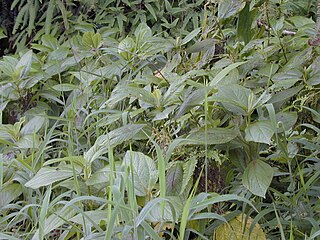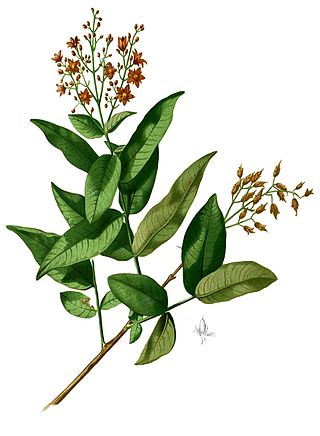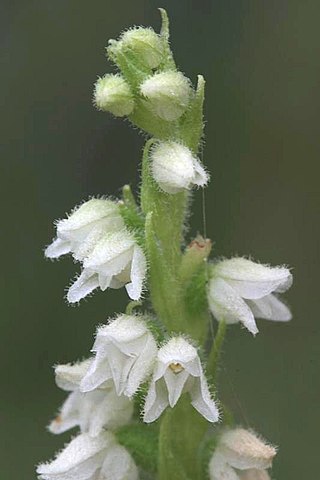
Meliaceae, the mahogany family, is a flowering plant family of mostly trees and shrubs in the order Sapindales.

The Moraceae—often called the mulberry family or fig family—are a family of flowering plants comprising about 38 genera and over 1100 species. Most are widespread in tropical and subtropical regions, less so in temperate climates; however, their distribution is cosmopolitan overall. The only synapomorphy within the Moraceae is presence of laticifers and milky sap in all parenchymatous tissues, but generally useful field characters include two carpels sometimes with one reduced, compound inconspicuous flowers, and compound fruits. The family includes well-known plants such as the fig, banyan, breadfruit, jackfruit, mulberry, and Osage orange. The 'flowers' of Moraceae are often pseudanthia.

In the botanical classification of plants, Aeridinae Pfitzer is a subtribe of the tribe Vandeae whose representatives all have a monopodial growth habit and do not possess pseudobulbs.

Trema is a genus of about 15 species of evergreen trees closely related to the hackberries (Celtis), occurring in subtropical and tropical regions of southern Asia, northern Australasia, Africa, South and Central America, and parts of North America. They are generally small trees, reaching 10–20 m (33–66 ft) tall.

Melastomataceae is a family of dicotyledonous flowering plants found mostly in the tropics comprising c. 175 genera and c. 5115 known species. Melastomes are annual or perennial herbs, shrubs, or small trees.

Charles Ludwig de Blume or Karl Ludwig von Blume was a German-Dutch botanist. The standard author abbreviation Blume is used to indicate this person as the author when citing a botanical name.

Boehmeria is a genus of 47 species of flowering plants in the nettle family Urticaceae. Of the species, 33 are indigenous to the Old World and 14 to the New World; no species is indigenous to both the Old and New Worlds. The species include herbaceous perennials, shrubs and small trees. Although related to the similar-looking species of the stinging nettles of genus Urtica, species of Boehmeria do not have stinging hairs. Because of the similarity in appearance, some species are commonly called "false nettles".

Cratoxylum is a genus of flowering plants in the family Hypericaceae, native to tropical Asia. The generic name means "strong wood", referring to the timber.

Dysoxylum is a genus of rainforest trees and shrubs in the flowering plant family Meliaceae. About 34 species are recognised in the genus, distributed from India and southern China, through southeast Asia to New Guinea, Solomon Islands, and Australia. The name Dysoxylum derives from the Greek word ‘Dys’ meaning "bad" referring to "ill-smelling" and ‘Xylon’ meaning "wood".

Hydnocarpus is a genus of medium to large trees in the Family Achariaceae; the genus was previously placed in the now defunct family Flacourtiaceae. Species have been recorded from Indochina, Indonesia, Malaysia and the Philippines.

Daphniphyllum is the sole genus in the flowering plant family Daphniphyllaceae and was described as a genus in 1826. The genus includes evergreen shrubs and trees mainly native to east and southeast Asia, but also found in the Indian Subcontinent and New Guinea.

Escalloniaceae is a family of flowering plants consisting of about 130 species in eight genera. In the APG II system it is one of eight families in the euasterids II clade (campanulids) that are unplaced as to order. More recent research has provided evidence that two of those families, Eremosynaceae and Tribelaceae, arose from within Escalloniaceae; the Angiosperm Phylogeny Website therefore merges these two families into Escalloniaceae, and also places the family alone in order Escalloniales.

Goodyera, commonly called rattlesnake plantain, jade orchids or ladies' tresses is a wide-ranging genus of orchids in the tribe Cranichideae. About 100 species of Goodyera have been formally described. With a center of diversity in East Asia, Goodyera is found across Europe, Madeira, North and Central America, Australia, and on islands from the west Indian Ocean to the Pacific Ocean. They have a rosette of leaves at their base and usually many small white resupinate flowers. They are similar to orchids in the genus Spiranthes but can be distinguished from them by the shape and colour patterns of the leaves.

Buchanania is a genus of plants in the mango and cashew family Anacardiaceae, native to areas from India to southern China, and southwards to northern Australia and the western Pacific.

Fagraea is a genus of plants in the family Gentianaceae. It includes trees, shrubs, lianas, and epiphytes. They can be found in forests, swamps, and other habitat in Asia, Australia, and the Pacific Islands, with the center of diversity in Malesia.

Vatica is a genus of plants in the family Dipterocarpaceae. Its species range from India and southern China through Sri Lanka, Indochina, Indonesia, the Philippines, and New Guinea.

Rhynchostylis is a genus in the orchid family (Orchidaceae), closely allied to the genus Vanda and comprising four currently accepted species native to the Indian Subcontinent, China, Indochina, Malaysia, Indonesia and the Philippines.

Korthalsia is a clustering genus of flowering plant in the palm family spread throughout Southeast Asia. It is a highly specialized rattan with some species known to have an intimate relationship with ants, hence the common name ant rattan. High-climbing and armed with spines, the genus is named for the Dutch botanist P. W. Korthals who first collected them from Indonesia.

Hornstedtia is a genus of plants in the Zingiberaceae. It is native to Southeast Asia, the Himalayas, southern China, New Guinea, Melanesia and Queensland.
Phytocrene is a genus of flowering plants belonging to the family Icacinaceae.


















